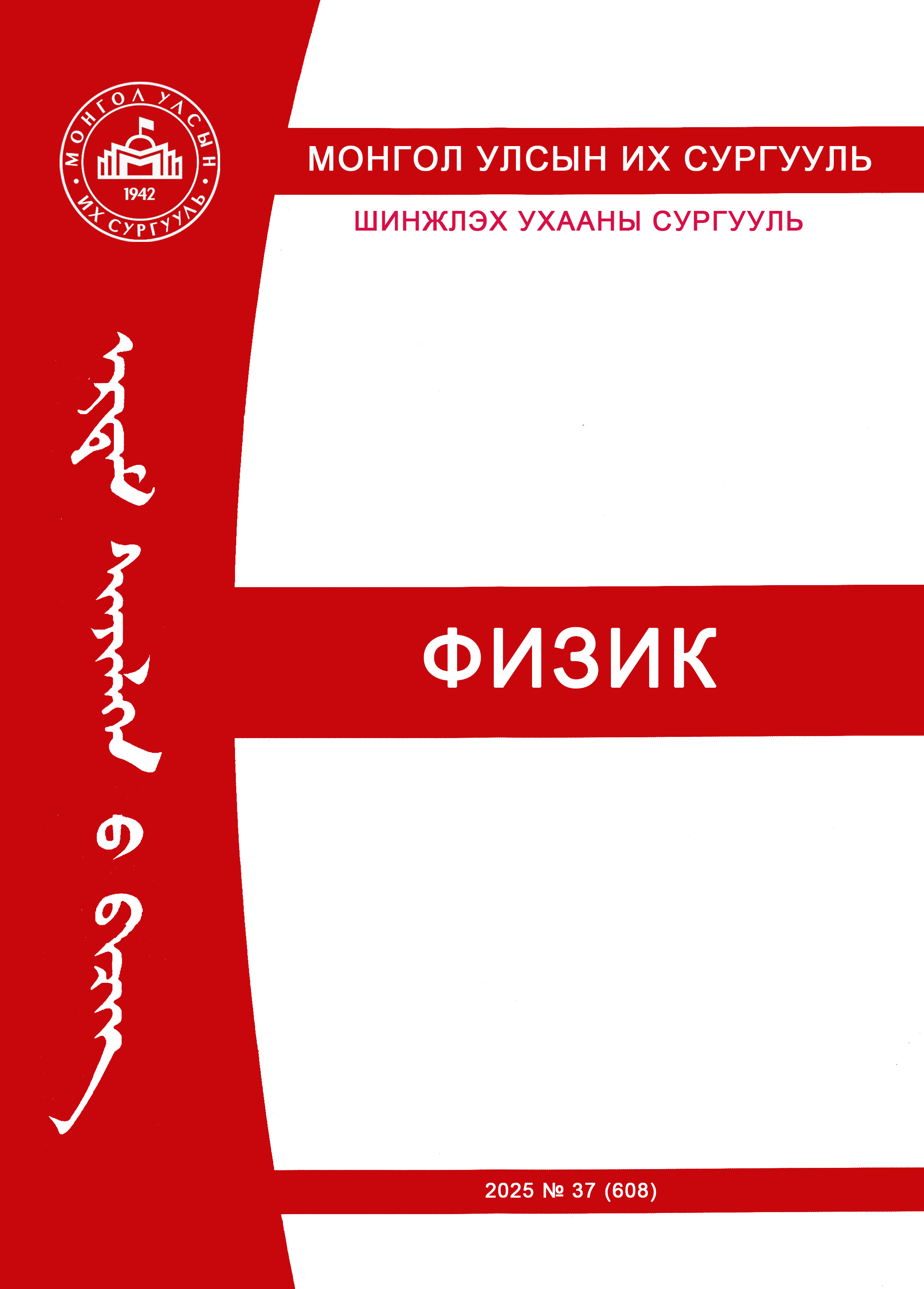Нарны зайн системийн илүүдэл энергийг дулаан хангамжид ашиглах автомат удирдлагын төхөөрөмж
The control of using of excess energy from solar panels as thermal energy
DOI:
https://doi.org/10.22353/physics.v37i608.8910Keywords:
нарны зай, автомат удирдлага, дулаан хуримтлуур, илүүдэл энерги, нарны зайн системAbstract
Энэ судалгааны ажлаар нарны зайн дэлгэцийн цахилгааны үйлдвэрлэл инверторын чадлаас давсан илүүдлийг мэдэрч, илүүдсэн хэсгийг автоматаар тасалж, хуваарилах үүрэгтэй төхөөрөмжийг бүтээж, туршсан үр дүнг танилцуулна. Энэхүү төхөөрөмж нь нарны зайн бүлийн гаралт болон инверторын тогтмол гүйдлийн оролт хоёрын дунд тавигдах ба инверторын чадлаас хэтэрсэн энергийг тасалж, тогтмол гүйдлийн халаагуур руу дамжуулж, танкан дахь усыг халаах зорилготой. Тус удирдлагын төхөөрөмжийн туршилтын загварыг Arduino-Uno микро контроллер болон соронзон релейнүүд ашиглан бүтээж, гурван кВт-ын нарны зайн систем дээр урт хугацаанд туршсан. Туршилтын үр дүнг нар гийгүүлэлтээрээ ялгаатай өдрүүд дээр харьцуулан дүгнэв. 4-р сарын 11-ний өдөр нарны зайн дэлгэцээс үйлдвэрлэсэн энергийн 22.9 % -ийг, 4-р сарын 13-ны өдөр 17.6 % -ийг, 4-р сарын 28-ны өдөр 24.3 % -ийг танканд дулааны энерги болгон хадгалсан байна.
This paper presents the experimental result of a new automatic control device that measures solar PV output power and regulates energy excessed over solar inverter capacity. This device, arranged between the solar PV panels’ output and the inverter's DC input, sends the excess energy to the DC electric heater to accumulate as thermal energy in a tank. A prototype of the control device was designed using an Arduino-Uno microcontroller and some magnetic relays and connected to a 3.3 kW solar PV system to conduct long-term experiments under real environmental conditions. To show the experimental results, three different days in terms of daily solar irradiation are compared. On April 11, 22.9% of the energy produced by the system was stored as thermal energy in a water tank; on April 13, 17.6%; and on April 28, 24.3%.
Downloads
References
Sayed, E. T., Wilberforce, T., Elsaid, K., Rabaia, M. K. H., Abdelkareem, M. A., Chae, K.-J., & Olabi, A. G. (2021). A critical review on environmental impacts of renewable energy systems and mitigation strategies: Wind, hydro, biomass and geothermal. Science of the Total Environment, 766, 144505. https://doi.org/10.1016/j.scitotenv.2020.144505
[10] H. Alsharif, M., Kannadasan, R., Y. Hassan, A., Z. Tawfik, W., Kim, M.-K., Asghar Khan, M., & A. A. Solyman, A. (2022). Optimization Analysis of Sustainable Solar Power System for Mobile Communication Systems. Computers, Materials & Continua, 71(2), 3243–3255. https://doi.org/10.32604/cmc.2022.022348
[11] Shaban, H., Houssein, E. H., Pérez-Cisneros, M., Oliva, D., Hassan, A. Y., Ismaeel, A. A. K., AbdElminaam, D. S., Deb, S., & Said, M. (2021). Identification of Parameters in Photovoltaic Models through a Runge Kutta Optimizer. Mathematics, 9(18), 2313. https://doi.org/10.3390/math9182313
Green, M. A. (1982). Solar Cells. Prentice Hall.
[13] Guerra, N., Guevara, M., Palacios, C., & Crupi, F. (2018). Operation and physics of photovoltaic solar cells: an overview. I+D Tecnológico, 14(2), 84–95. https://doi.org/10.33412/idt.v14.2.2077
Mohammadi, K., Khanmohammadi, S., Khorasanizadeh, H., & Powell, K. (2020). A comprehensive review of solar only and hybrid solar driven multigeneration systems: Classifications, benefits, design and prospective. Applied Energy, 268, 114940. https://doi.org/10.1016/j.apenergy.2020.114940
M.S. Ismail, M. Moghavvemi, T.M.I. Mahlia, K.M. Muttaqi, S. Moghavvemi, (2015) Effective utilization of excess energy in standalone hybrid renewable energy systems for improving comfort ability and reducing cost of energy: A review and analysis, Renewable and Sustainable Energy Reviews, Volume 42, , Pages 726-734, ISSN 1364-0321, https://doi.org/10.1016/j.rser.2014.10.051
Figaj, R. (2021). Performance assessment of a renewable micro-scale trigeneration system based on biomass steam cycle, wind turbine, photovoltaic field. Renewable Energy, 177, 193–208. https://doi.org/10.1016/j.renene.2021.05.143
Amin, M., Alibakhsh Kasaeian, Niu, X., Zhang, K., & Omid Mahian. (2023). Excess electricity problem in off-grid hybrid renewable energy systems: A comprehensive review from challenges to prevalent solutions. 212, 538–560. https://doi.org/10.1016/j.renene.2023.05.073
Elboshy, B., Alwetaishi, M., M. H. Aly, R., & Zalhaf, A. S. (2022). A suitability mapping for the PV solar farms in Egypt based on GIS-AHP to optimize multi-criteria feasibility. Ain Shams Engineering Journal, 13(3), 101618. https://doi.org/10.1016/j.asej.2021.10.013
Tungaa.B, Turmandakh.B, Purevdalai.E, “A study on the use of excess energy from PV panels as heat”, Хүрэлтогоот-2023 эрдэм шинжилгээний хурлын эмхэтгэл, хуудас 25-32, ISBN 978-9919-9814-9-5
Downloads
Published
How to Cite
License
Copyright (c) 2024 Scientific transaction of the National University of Mongolia. Physics

This work is licensed under a Creative Commons Attribution-NonCommercial-ShareAlike 4.0 International License.






